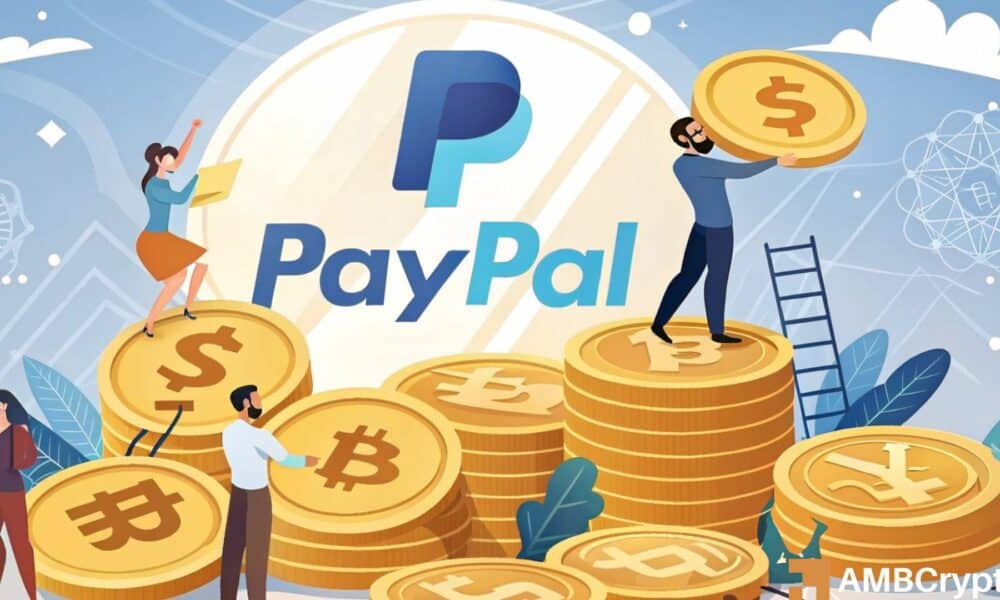Key takeaways
PayPal’s crypto journey began in 2020, expanding features, launching PYUSD stablecoin, and reshaping public perception—bridging traditional finance with digital assets while facing regulatory scrutiny and public skepticism.
PayPal once viewed cryptocurrency with open disdain, but the payments giant has since completely reversed course, becoming a major player in the digital money world.
It wasn’t a sudden change of heart; the company’s shift was a deliberate move, pushed by intense competition, undeniable market trends, and a new idea of what money could become.
The big jump in 2020
In October 2020, PayPal made a major strategic shift by allowing U.S. users to buy, hold, and sell Bitcoin [BTC], Ethereum [ETH], Litecoin [LTC], and Bitcoin Cash [BCH] directly through their accounts.
This move wasn’t random—it came as the crypto market surged past $1 trillion, creating a massive growth opportunity.
PayPal recognized that its younger, tech-savvy users were eager to access digital assets. Meanwhile, competitors like Square (now Block) had already entered the crypto space, and PayPal didn’t want to fall behind.
The COVID-19 pandemic also accelerated the shift toward digital payments, making consumers more open to digital currencies.
CEO Dan Schulman called the transition to digital money “inevitable” and aimed to simplify crypto for everyday users.
To navigate regulatory challenges and build a secure infrastructure, PayPal partnered with Paxos Trust Company, a regulated crypto firm. This collaboration enabled PayPal to integrate crypto services seamlessly while complying with financial regulations.
Going all in on crypto
After its 2020 debut, PayPal didn’t waste time adding more crypto features. By early 2021, you could use your crypto balance to pay at millions of stores that take PayPal.
The system cleverly converts the crypto to regular money for the merchant, so businesses didn’t have to worry about price swings. This made crypto feel more like real cash for everyday shopping.
A couple of months later, in April 2021, these crypto services came to Venmo, PayPal’s other popular payment app, clearly targeting a younger crowd.
The company showed it was serious by creating a whole new business division just for blockchain and digital currencies.
The biggest move came in August 2023 when PayPal launched its own stablecoin, PayPal USD (PYUSD). This digital dollar, also issued by Paxos, was a huge step toward weaving crypto into the fabric of the platform.
The idea was to create a stable, efficient way for digital payments, a kind of glue between traditional banking and Web3 that promised faster and cheaper transactions.
More recently, PayPal supercharged its “Pay with Crypto” service, letting U.S. merchants accept over 100 different cryptocurrencies, which could cut cross-border fees by up to 90% and give businesses their money almost instantly.
PayPal’s ripple effect on crypto
PayPal’s decision to embrace cryptocurrency has done more than just add a new feature; it has changed how the public sees digital assets, giving a stamp of legitimacy to a market that was often viewed with suspicion.
When PayPal first let U.S. users buy, hold, and sell a few major cryptocurrencies in October 2020, it was a watershed moment.
Millions of people suddenly had a trusted and familiar way to interact with crypto for the first time, without having to navigate the steep learning curve of specialized exchanges.
The platform’s easy-to-use design and reputation for security helped make crypto less intimidating for the average person.
PayPal also cleverly shielded businesses from crypto’s price swings by instantly converting crypto payments into regular money, removing a major hurdle for merchant adoption.
This move sent a clear message to Wall Street and other big financial companies. When a leading fintech firm like PayPal pivots to crypto, it forces others to pay attention and consider how they can do the same.
The launch of PayPal’s own stablecoin, PYUSD, in August 2023 was an even stronger signal that the company was serious about building the infrastructure to connect crypto and traditional finance.
With its recent “Pay with Crypto” feature, which lets U.S. merchants accept over 100 different coins, PayPal is pushing further into everyday commerce.
The service aims to slash international transaction costs, connecting businesses with a massive global pool of crypto users.
This is all part of PayPal’s grander vision of a “PayPal World” that connects different payment systems globally, with crypto acting as a key piece of the puzzle.
The regulatory maze
PayPal had to navigate a dizzying maze of regulations to launch its crypto services in the U.S. and the U.K. The company has walked a fine line, trying to stay compliant in a world where the rules for digital money are constantly changing and often unclear.
In the United States, there’s still no single rulebook for crypto. Instead, a handful of federal agencies have staked their claim.
The U.S. Securities and Exchange Commission (SEC) is focused on whether cryptos are securities, the CFTC treats Bitcoin as a commodity, and FinCEN requires crypto businesses to follow anti-money laundering (AML) laws.
On top of that, each state has its own set of rules, often requiring separate licenses to operate.
The United Kingdom has moved more deliberately toward a complete set of rules. The Financial Conduct Authority (FCA) oversees the crypto market with a heavy focus on consumer protection and AML compliance.
The government plans to regulate a wider range of crypto activities, bringing them in line with traditional finance.
To operate in this environment, PayPal has had to be meticulous. In the U.S., it meant getting licenses in numerous states and sticking to a patchwork of federal and state rules.
In the U.K., it involved registering with the FCA and even temporarily pausing crypto sales to comply with new regulations.
Looking ahead, PayPal seems to be banking on its strategy of working closely with regulators and building its services with compliance in mind.
As governments in both the U.S. and U.K. move toward clearer regulations, especially for stablecoins, PayPal’s own PYUSD and its reputation as a regulated company could give it a major advantage.
PYUSD: PayPal’s bid to remake payments
The launch of its own stablecoin, PYUSD, in August 2023 was a key moment.
This made PayPal one of the first major American tech firms to issue its own digital dollar, a bold bet on the future of blockchain technology.
Issued by the regulated firm Paxos, PYUSD is designed to be a trusted digital dollar, fully backed by cash and U.S. government bonds.
It was built to work seamlessly within PayPal’s ecosystem, allowing users to buy, sell, and hold it, send it to friends on PayPal and Venmo, and use it to fund purchases.
By building it on the popular Ethereum blockchain, PayPal ensured it could work with thousands of existing crypto apps and wallets.
At press time, PYUSD’s market value was at $1.2 billion, a sign that both regular people and larger institutions are starting to use it.
Risks ahead for PayPal’s crypto bet
As a payments giant, PayPal’s push into crypto is a high-stakes gamble. While the company is positioning itself to be a key player in the digital economy, its path is filled with serious long-term risks.
The wild price swings of the crypto market are a constant threat. Even though PayPal shields merchants from volatility, a major market crash could scare off users, damage PayPal’s reputation, and slash the revenue it makes from trading fees.
The crypto world is also a massive target for hackers and scammers. A major security breach at PayPal could be catastrophic, leading to huge financial losses and a complete collapse of user trust.
Perhaps the biggest long-term threat comes from the very technology PayPal is embracing: decentralized finance, or DeFi. DeFi platforms offer financial services like lending and trading directly on the blockchain, without intermediaries.
They often have lower fees and give users complete control over their funds. The core idea of DeFi is to cut out the middleman, which poses an existential threat to PayPal’s entire business model.
PayPal’s vision for NFTs, DeFi, and identity
PayPal’s ambitions in the blockchain space go far beyond simple payments. The company is actively laying the groundwork to integrate NFTs, explore DeFi services, and invest in digital identity solutions, hoping to become a one-stop shop for the Web3 economy.
The company has filed a patent for an NFT marketplace that would support advanced features like letting multiple people co-own a single high-value NFT.
The plan suggests a future where users can manage a whole portfolio of tokenized assets, from digital art to legal documents, right from their PayPal account.
With the launch of its PYUSD stablecoin, PayPal has already taken a big step into DeFi. The strategy is to integrate PYUSD with DeFi lending platforms, allowing users to earn interest on their holdings. This move positions PayPal to compete with other stablecoin giants by leveraging its huge user base.
Underpinning all of this is a focus on digital identity. Years ago, PayPal invested in Cambridge Blockchain, a startup focused on giving people more control over their online identities.
This shows PayPal understands that a trusted and secure way to verify identity is essential for the future of Web3, whether it’s for buying NFTs or using DeFi services.







